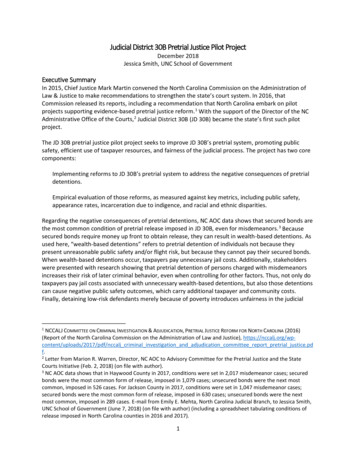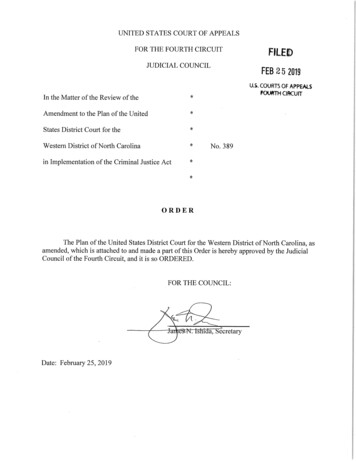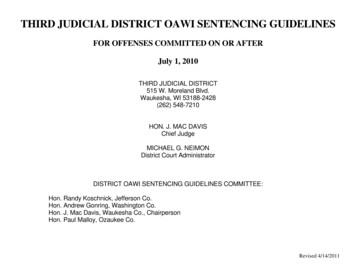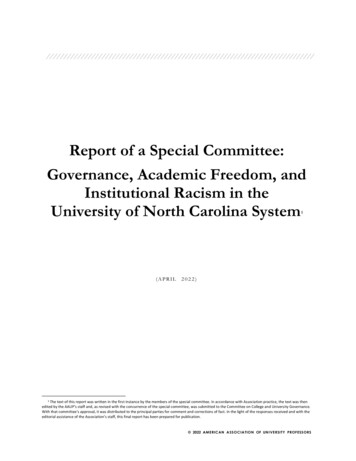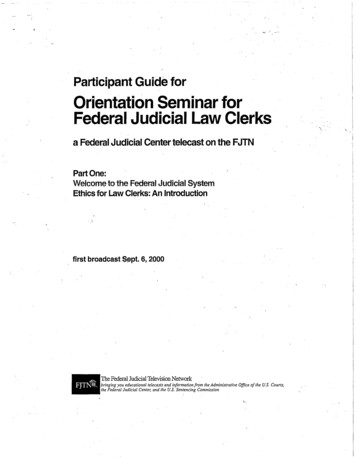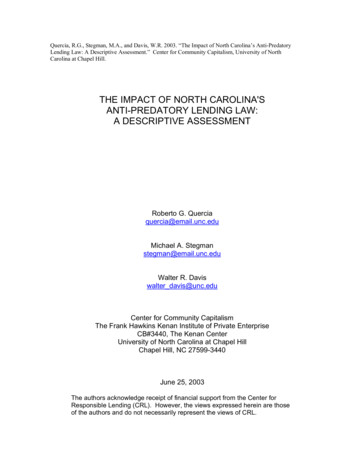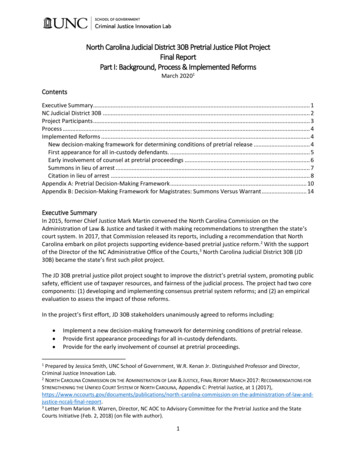
Transcription
North Carolina Judicial District 30B Pretrial Justice Pilot ProjectFinal ReportPart I: Background, Process & Implemented ReformsMarch 20201ContentsExecutive Summary. 1NC Judicial District 30B . 2Project Participants . 3Process . 4Implemented Reforms . 4New decision-making framework for determining conditions of pretrial release . 4First appearance for all in-custody defendants. . 5Early involvement of counsel at pretrial proceedings . 6Summons in lieu of arrest . 7Citation in lieu of arrest . 8Appendix A: Pretrial Decision-Making Framework . 10Appendix B: Decision-Making Framework for Magistrates: Summons Versus Warrant . 14Executive SummaryIn 2015, former Chief Justice Mark Martin convened the North Carolina Commission on theAdministration of Law & Justice and tasked it with making recommendations to strengthen the state’scourt system. In 2017, that Commission released its reports, including a recommendation that NorthCarolina embark on pilot projects supporting evidence-based pretrial justice reform.2 With the supportof the Director of the NC Administrative Office of the Courts,3 North Carolina Judicial District 30B (JD30B) became the state’s first such pilot project.The JD 30B pretrial justice pilot project sought to improve the district’s pretrial system, promoting publicsafety, efficient use of taxpayer resources, and fairness of the judicial process. The project had two corecomponents: (1) developing and implementing consensus pretrial system reforms; and (2) an empiricalevaluation to assess the impact of those reforms.In the project’s first effort, JD 30B stakeholders unanimously agreed to reforms including: Implement a new decision-making framework for determining conditions of pretrial release.Provide first appearance proceedings for all in-custody defendants.Provide for the early involvement of counsel at pretrial proceedings.1Prepared by Jessica Smith, UNC School of Government, W.R. Kenan Jr. Distinguished Professor and Director,Criminal Justice Innovation Lab.2NORTH CAROLINA COMMISSION ON THE ADMINISTRATION OF LAW & JUSTICE, FINAL REPORT MARCH 2017: RECOMMENDATIONS FORSTRENGTHENING THE UNIFIED COURT SYSTEM OF NORTH CAROLINA, Appendix C: Pretrial Justice, at 1 on-of-law-andjustice-nccalj-final-report.3Letter from Marion R. Warren, Director, NC AOC to Advisory Committee for the Pretrial Justice and the StateCourts Initiative (Feb. 2, 2018) (on file with author).1
Promote the increased use of summons in lieu of arrest in appropriate cases.Promote the increased use of citation in lieu of arrest in appropriate cases.Reforms took effect January 1, 2019.Part II of this report details the findings from an empirical evaluation of the project.NC Judicial District 30BJD 30B consists of two counties in Western North Carolina: Haywood and Jackson. Several features ofthe counties are displayed in Table 1 below; their geographic location in the state is shown in Figure 1below.Table 1. Haywood & Jackson Racial Composition %White / Black / Am. Indian /Hispanic292.53% / 1.23% / 0.50% /4.06%81.06% / 2.11% / 8.03% /5.87%2016 GeneralElection %Trump /Clinton3Violent Crime Rate 2017 /Property Crime Rate 2017(State Rate: 384 / 2,678)4MedianHouseholdIncome5PovertyRate62015 JailPop. Per100k762% / 34%302 / 2,848 47,87214.5%31453% / 41%251 / 2,848 46,11317.0%198Notes1 US Census Bureau, Population Division, Annual Estimates of the Resident Population by Sex, Race, and Hispanic Origin for the United States, States, andCounties: April 1, 2010 to July 1, 2018 (June 2019) (UNC Carolina Population Center provided this U.S. Census Bureau data in spreadsheet format).2Id. (People of any race may be of Hispanic ethnicity. This chart does not include Hispanics in the percentages displayed in the White/Black/Am. Indiancategories, instead displaying the total percentage of Hispanics regardless of race in the Hispanic category).3North Carolina State Board of Elections, Election Results, https://www.ncsbe.gov/Election-Results (last visited Sept. 9, 2019) (percentages have beenrounded to nearest whole number).4NORTH CAROLINA STATE BUREAU OF INVESTIGATION, CRIME IN NORTH CAROLINA – 2017 (2018) (rates have been rounded to nearest whole number), available 2017%20Annual%20Summary.pdf.5North Carolina Department of Commerce, Economic Development Reports, omic-developmentreports (last visited Sept. 9, 2019) (this chart relies on information in the Department’s dynamic “Area Demographic Profiles,” which are available fordownload at the link in this citation).6Id.7 VeraInstitute of Justice, Incarceration Trends – Jail Incarceration Rate, http://trends.vera.org/incarceration-rates?year 2015 (last visited Sept. 9, 2019)(Vera notes that some data may merit further inquiry for accuracy.).2
Figure 1. State Map Showing Haywood & Jackson CountiesProject ParticipantsThe pilot project was initiated and led by Senior Resident Superior Court Judge Bradley B. Letts. Otherjudicial system participants included District Court Judges; Magistrates; Clerks of Court; the DistrictAttorney and Assistant District Attorneys in that office; defense lawyers; and members of the lawenforcement community, broadly defined to include sheriff and police departments, campus police, andjail administrators.The project was supported by: Jessica Smith, W.R. Kenan, Jr. Distinguished Professor, School of Government and Director,Criminal Justice Innovation Lab, The University of North Carolina at Chapel Hill. Smith supportedthe project by helping to secure project funding; facilitating stakeholder meetings; providinglegal advice and analysis; developing and writing Implementation Plans for each implementedreform; coordinating data collection from the NC AOC; and writing this and other reports.Funding from Smith’s endowed professorship covered her travel to and from JD 30B, meals formeeting participants, printing of the Cite or Arrest pocket card for officers and the new pretrialrelease decision-making rubric, and graduate student research support for the empiricalevaluation.Professor Jamie Vaske, Associate Professor, Western Carolina University. Vaske led the project’sevaluation component including designing evaluation plans; securing funding for evaluations;obtaining Institutional Review Board approval; supervising student support; working withstakeholders to develop systems to collect key data points; data collection and analysis; andpreparing the final evaluation and other reports.Tom Maher, Executive Director, NC Indigent Defense Services (NC IDS) and NC IDS. Maherplayed a key role in implementation of the early involvement of counsel reform; NC IDSsupported the project by paying contract lawyers’ fees and administering the early involvementof counsel program.NC AOC Research and Planning. Staff in the NC AOC office of Research and Planning providedassistance with respect to collecting and understanding NC AOC data.3
State Justice Institute (SJI). The project’s first effort was supported by a grant from the SJI,administered by the National Center for State Courts and the Pretrial Justice Institute (PJI).Grant funding supported technical assistance by PJI. Specifically, PJI’s Will Cash and John Clarkled the project’s kick-off meetings. Clark served as a project consultant and led training forstakeholders on new pretrial procedures.ProcessThe project began with two public “kick off” meetings in June 2018—one in Haywood County; one inJackson County. At those meetings Cash and Clark presented on, among other things, problems with thecurrent pretrial release systems; the negative consequences of unnecessary pretrial detention—both fordefendants and communities; legal and evidence-based pretrial practices; pretrial reform effortsimplemented and underway around the country; the results of such reforms and support for them froma wide variety of groups, including the Conference of Chief Justices, the National Sheriffs Association,the Association of Prosecuting Attorneys, and a broad range of advocacy groups; and growing pressurefor reform caused by successful legal challenges to existing bail systems. PJI staff also facilitated adiscussion in which stakeholders prioritized reforms they wished to implement in JD 30B.After the June meeting, Professor Smith prepared draft Implementation Plans for the reforms prioritizedby stakeholders. In August 2018, Smith facilitated a public meeting with stakeholders to refine thoseplans. She then incorporated stakeholder feedback and produced revised Implementation Plans. Shefacilitated a public meeting in September 2018 for stakeholders to review the revised plans; thisincluded testing the new pretrial decision-making framework through a series of case scenarios.Between meetings, Smith communicated with stakeholders, getting additional feedback on plan details,addressing areas of concern, and preparing revised Implementation Plans incorporating this feedback.On a parallel track, Professor Vaske attended meetings and designed and developed evaluation plans forall identified reforms, including obtaining approvals and permissions from NC AOC, IRB, and others. Afinal meeting was held in December 2018, primarily to provide training on all of the adopted reforms,but also for final refinement of Implementation Plans and tools. After that meeting Smith finalized andarranged for printing and delivery of necessary materials, worked with Clark to develop a training guideon the new Cite or Arrest pocket card for officers, and Judge Letts issued a revised Local Bail Policy andnecessary Standing Orders.Implemented ReformsNew decision-making framework for determining conditions of pretrial releasePrior to implementation of project reforms, JD 30B’s Local Bail Policy included a table setting suggestedbond amounts based on the punishment class of the charged offense. Best practices recommend againstthe use of such tables.4 Additionally, stakeholders determined that although the current charge’soffense class is relevant to the bail decision, other individualized factors regarding the defendant andthe circumstances of the offense should be considered in assessing appropriate conditions of pretrialrelease and that consideration of additional factors is required by state law.5 Moreover there was someconcern that the use of a bond table may push decision-makers towards a presumption of secured bond4AMERICAN BAR ASSOCIATION, ABA STANDARDS FOR CRIMINAL JUSTICE: PRETRIAL RELEASE, Standard 10-5.3(e) (3d ed. 2007)("Financial conditions should be the result of an individualized decision taking into account the specialcircumstances of each defendant, the defendant's ability to meet the financial conditions and the defendant'sflight risk, and should never be set by reference to a predetermined schedule of amounts fixed according to thenature of the aba/publications/criminal justice standards/pretrial release.pdf.5G.S. 15A-534(c).4
in contravention of state law, which requires release on a written promise, custody release, orunsecured bond unless the decision-maker finds that those conditions will not reasonably assureappearance; will pose a danger of injury to any person; or are likely to result in the destruction ofevidence, subornation of perjury, or intimidation of witnesses.6 And finally, stakeholders wanted todevelop an easily implemented tool to help judicial officials quickly identify those defendants who canbe released on nonfinancial conditions, to reduce the occurrence of wealth-based incarceration ofindividuals who pose little risk to public safety or of non-appearance in court. Although they consideredempirical risk assessment tools (sometimes referred to as “algorithms”) for that purpose, they did notopt for such a tool. Instead, they adopted a new structured decision-making tool to better informjudicial officials’ pretrial decisions and conform with constitutional and statutory requirements.JD 30B’s new structured decision-making tool is included in Appendix A. It applies in all circumstancesexcept where the statutes or local policy require other considerations or outcomes. Key featuresinclude: Expressly incorporating the statutory requirement that a judicial official “must” impose a writtenpromise, custody release or unsecured bond (“nonfinancial conditions”) unless the official“determines that such release will not reasonably assure the appearance of the defendant asrequired; will pose a danger of injury to any person; or is likely to result in destruction ofevidence, subornation of perjury, or intimidation of potential witnesses.”7Providing an easily implemented checklist to quickly identify low-risk defendants who can bereleased on nonfinancial conditions.Providing that for individuals charged with the most serious offenses, no presumption orscreening applies; decision-makers proceed directly to the required statutory determination.Requiring documentation of reasons for imposing a secured bond.Requiring that ability to pay be considered when setting a secured appearance bond.Requiring detention bond hearings when a secured detention bond is imposed.Providing a maximum bond table.Preserving necessary discretion by allowing for deviations from all tool recommendations.First appearance for all in-custody defendants.Stakeholders resolved to provide first appearances for in-custody defendants charged withmisdemeanors and Class H and I felonies (highest charge) or arrested on a probation violation within 72hours of arrest or at the first regular session of the district court in the county, whichever occurs first.State law requires a first appearance for in-custody felony defendants within 96 hours of being takeninto custody or at the first regular session of the district court in the county, whichever occurs first.8Because the law does not require first appearances for in-custody misdemeanor defendants, thesedefendants may sit in jail for weeks or more until their first court date. This can lead to scenarios wheremisdemeanor defendants are incarcerated pretrial when the charged offense cannot result in acustodial sentence upon conviction or where they are incarcerated pretrial for a longer period than theycould receive in a custodial sentence if convicted. Additionally, stakeholders learned of researchsuggesting that pretrial detention of low-level defendants has negative public safety consequences andnegative case outcomes for defendants. They concluded that these reasons counsel in favor of first6G.S. 15A-534(b).Id.8G.S. 15A-601(c).75
appearances for in-custody misdemeanor defendants, to ensure prompt judicial review of themagistrate’s bond determination and a determination that detention is warranted because of pretrialrisk as opposed to inability to pay financial conditions. Additionally, a separate reform (discussed below)provides for NC IDS contract counsel for in-custody defendants charged with misdemeanors and Class Hand I felonies as well as those arrested on probation violations; the new first appearances are necessaryto effectuate that reform.To promote judicial efficiency, stakeholders decided to hold the new first appearances at 2 pm in districtcourt. Holding these proceedings in the afternoon affords new contract counsel (see below) time tomeet with clients at the jail and to obtain and review defendants’ criminal history record.Early involvement of counsel at pretrial proceedingsEarly involvement of counsel at pretrial proceedings will better inform judges’ pretrial decisions andprotect defendants’ rights in light of the significant consequences associated with pretrial detention.9Early involvement of counsel is recommended by national standards10 and has been specificallyrecommended for North Carolina.11To implement this reform Judge Letts issued a Standing Order providing for the appointment of NC IDSretained “contract counsel” to represent defendants at the first appearance and the first detentionbond hearing (if any). Covered defendants included those whose highest charge is a misdemeanor orClass H or I felony and those arrested for a probation violation. Contract counsel were required to meetwith defendants at the jail and review defendants’ criminal history records prior to the first appearance.Contract counsel were retained and paid pursuant to contracts with NC IDS and served only for thesepurposes; assigned counsel was appointed to represent defendants after the first appearance and firstdetention bond hearing (if any).To implement this reform, NC IDS agreed to: Hire, contract, and supervise contract counsel.Set payment rates for contract counsel and approve all payments to contract counsel.Establish procedures for handling defendants who are arrested on an Order for Arrest for aFailure to Appear and already have assigned counsel.Develop contracts specifying performance expectations, including: meeting with the client at thejail before the first appearance; reviewing the client’s criminal history; preparing an intake formfor each defendant; and advocating for the client at the first appearance and the first detentionbond hearing (if any).9See, e.g., Paul Heaton et al., The Downstream Consequences of Misdemeanor Pretrial Detention, 69 STAN. L. REV.711 (2017), etention/.10ABA STANDARDS FOR CRIMINAL JUSTICE: PROSECUTION AND DEFENSE FUNCTION, Defense Function Standard 4-2.3 (4th ed.2017) ("A defense counsel should be made available in person to a criminally-accused person for consultation at orbefore any appearance before a judicial officer, including the first riminal NORTH CAROLINA COMMISSION ON THE ADMINISTRATION OF LAW & JUSTICE, FINAL REPORT MARCH 2017: RECOMMENDATIONS FORSTRENGTHENING THE UNIFIED COURT SYSTEM OF NORTH CAROLINA, Appendix D: Improving Indigent Defense Services, at 30(2017), w-and-justice-nccalj-final-report.6
Establish a plan to train contract counsel on pretrial advocacy, as feasible.Establish procedures for dealing with conflicts.Develop forms and other job tools for contract counsel, such as an intake form to be used duringthe client interview.Local jail supervisors agreed to provide timely jail lists to contract counsel and to set aside a privatemeeting place for counsel to meet with jailed defendants prior to the first appearance.In order to meaningfully represent a defendant at first appearances and to ensure procedural fairness, itwas determined that contract counsel needs access to the defendant’s criminal history record, which isused by the ADA and judge at that proceeding. The District Attorney’s Office agreed to run these recordsfor each defendant on the 72-Hour Jail Calendar before the noon lunch hour; contract counsel went tothe District Attorney’s Office to review the records in advance of the new first appearances, which—asnoted above—were held at 2 pm to afford sufficient time for these tasks.Arrangements were made for interpreter services to be provided, as needed, to contract counselthrough the NC AOC telephonic interpreter services. Jail administrators agreed to allow telephones inclient meeting spaces for this purpose.Although stakeholders intended to implement this reform in both counties, NC IDS was unable tocontract with lawyers to perform this service in Jackson County. Thus, this reform was implemented onlyin Haywood County. It was effective in that county for all of 2019 but was suspended effective January 1,2020 due to judicial caseload management issues.12Summons in lieu of arrestRelated to the new decision-making framework for pretrial release decisions, this reform sought topromote the increased use of summons in lieu of arrest for cases where a defendant would be releasedon non-financial conditions and does not require pretrial restrictions.This change was designed to implement best practices,13 give effect to the statutory direction that awarrant for arrest should issue when a person needs to be taken into custody,14 give effect to statutoryrules regarding citizen’s warrants,15 and reduce wealth-based pretrial detentions of low-risk defendantswho cannot pay secured bonds imposed in their cases.This reform was accomplished by incorporating into the Local Bail Policy a new decision-makingframework for magistrates when deciding whether to issue a summons versus a warrant. The newdecision-making framework is provided in Appendix B.12Letter from Hon. Bradley B. Letts, Senior Resident Superior Court Judge and Hon. Richard K. Walker, ChiefDistrict Court Judge to Thomas K. Maher, Executive Director NC Indigent Defense Services (Dec. 20, 2019) (on filewith author).13ABA STANDARDS FOR CRIMINAL JUSTICE: PRETRIAL RELEASE, Standard 10-1.3 (3d ed. publications/criminal justice standards/pretrial release.authcheckdam.pdf.14G.S. 15A-304(b)(1).15G.S. 15A-304(b)(3).7
Citation in lieu of arrestThis reform was intended to include implementation of a law enforcement developed tool for patrolofficers to encourage the increased use of citations in lieu of arrest for certain misdemeanors, in theofficer’s discretion. Specifically, a Cite or Arrest Pocket Card, shown in Figure 2 below. Although theoverall project was a collaborative, multi-stakeholder endeavor, only the law enforcement communityparticipated in the creation of the Pocket Card.Figure 2. Cite or Arrest Pocket CardPromoting the increased use of citation in lieu of arrest is recommended by law enforcement and othergroups.16 Use of citations is widely embraced as a law enforcement tool,17 and promoting the greateruse of citations has been adopted as a criminal justice strategy elsewhere.18 Greater use of citationsoffers potential benefits, including increased efficiency for law enforcement.19 Promoting the increased16See, e.g., FINAL REPORT OF THE PRESIDENT’S TASK FORCE ON 21ST CENTURY POLICING 43 rce finalreport.pdf; ABA STANDARDS FOR CRIMINAL JUSTICE: PRETRIALRELEASE, Standard 10-1.3 (3d ed. publications/criminal justice standards/pretrial release.authcheckdam.pdf.17INTERNATIONAL ASSOCIATION OF CHIEFS OF POLICE, CITATION IN LIEU OF ARREST: EXAMINING LAW ENFORCEMENT’S USE OF CITATIONACROSS THE UNITED STATES (2016), , e.g., CHARLESTON COUNTY CRIMINAL JUSTICE COORDINATING COUNCIL (South Carolina), ANNUAL REPORT 2017(discussing increased use of “cite and release” practices in that les/2017annualreport.pdf.19INTERNATIONAL ASSOCIATION OF CHIEFS OF POLICE, supra note 17, at 3 (finding that citations require 24.2 minutes toprocess versus arrests, which require 85.8 minutes; citations thus offer a time savings of just over an hour perincident).8
use of citations in lieu of arrests also can help reduce unnecessary pretrial detentions of low-riskdefendants. Thus, it has been asserted that better decisions regarding whether to issue a citation versusmaking an arrest will promote officer efficiency, public safety, and efficient use of taxpayer funds.20Local law enforcement agencies agreed to distribute the pocket card to officers and provide training onits use.There is some question about implementation of this reform. In response to a survey about it, someofficer-respondents indicated that, among other things, they were unfamiliar with the pocket card; didnot receive training on the card; and did not receive the card or, if they did, did not carry or reference itwhen deciding whether to cite or arrest.20National Conference of State Legislatures, Citation in Lieu of Arrest (Mar. 1, 2019) (“States can use citations toreduce jail populations and provide local cost savings. Citations divert lower risk people from detention, reservinglimited space and resources for more dangerous people. By providing an alternative to pretrial detention andrelease processes for certain defendants, citation in lieu of arrest can be considered a component of state pretrialpolicies.”), stice/citation-in-lieu-of-arrest.aspx.9
Appendix A: Pretrial Decision-Making Framework10
11
12
13
Appendix B: Decision-Making Framework for Magistrates: Summons Versus WarrantIs thereprobable causethat Defendantcommitted thecrime?NoDecline toissueprocessYesIs the personwho providedprobablecause a swornofficer?Check any that apply:YesooooNoCheck any that apply:o There is corroboratingtestimony from a swornofficer1o There is evidence that havinglaw enforcement investigatewould create a substantialburden for the complainant1o There is corroboratingtestimony from adisinterested witness1o There is substantialevidence: of an FTA on aprior summons; thatDefendant will FTA; ofdanger of injury toperson/property; orseriousness of the offense1o The offense triggers the 48hour domestic violence holdruleoIf any boxis checkedooooooooooIf no box ischeckedCharged offense is a Class A-E felonyDefendant has insufficient ties to thecommunity to assure appearance2Defendant has a recent history of FTAs3Defendant has a prior record of-a felony conviction; or-misdemeanor convictions within the last 5years demonstrating a pattern of conduct 4Charged offense was committed whenDefendant was on pretrial release for arelated offense5 or on supervised probationfor any offenseCharged offense involves domestic violence6Charged offense is a felony & involvesviolence7Charged offense is a felony & resulted ininjury to a person8Charged offense requires sex offenderregistration9Charged offense is a failure to register as asex offender offense10Charged offense is a drug trafficking offense11Charged offense involves distribution ofdrugs12Defendant is impaired such that he/she islikely to cause harm to self/others/propertyCharged offense involved Defendant’s use ofa firearm or deadly weaponPretrial restrictions are needed (e.g., stayaway from victim)If no box ischeckedIssue asummons14If any boxis checkedWarrant maybe issued. If itis, reasonsmust bedocumented.13
1G.S. 15A-304(b)(3) (effective October 1, 2018, as enacted by S.L. 2018-40).The mere fact that the Defendant is homeless and does not have a home address does not warrant checking thisbox; inquiry should be focused on the Defendant’s connections to the community.3FTAs within the last 2 years are most relevant.4The pattern of conduct must relate to the present offense. For example: The current charge involves drugpossession and the Defendant has 3 priors within the last 5 years for misdemeanor drug or drug paraphernaliapossession.5This factor covers situations where the Defendant continues to engage in the same type of conduct (e.g., repeatlarceny) or an escalating course of conduct (e.g., the defendant is charged with injury to real property while thedefendant was on pretrial release for communicating threats to the property owner).6An offense involves domestic violence when the relationship between the parties is one of the following:o Current or former spouseso Currently or formerly lived together as if marriedo Currently or formerly in a dating relationshipo Have a child in commono Parent (or one in parental role)/childo Grandparent/grandchildo Current or former members of the same householdNote: this list is drawn from G.S. 15A-534.1, the 48-hour domestic violence hold statute.7For example, robbery.8This factor applies when the offense involved harm to a person (e.g., assaultive conduct). It does not apply tooffenses in which property is taken or harmed (e.g., larceny, embezzlement, obtaining property by false pretenses,etc.).9For a list of offenses requiring sex offender registration, see JAMIE MARKHAM & SHEA DENNING, NORTH CAROLINASENTENCING HANDBOOK 2017-18 (UNC School of Government, forthcoming 2018).10See G.S. 14-208.11(a); JESSICA SMITH, NORTH CAROLINA CRIMES: A GUIDEBOOK ON THE ELEMENTS OF CRIME 268 (7th Ed.2012) (discussing this offense).11See G.S. 90-95(h); NORTH CAROLINA CRIMES supra note 10, at 721-739 (discussing trafficking offenses).12For example, sale and delivery of a controlled substance and possession with intent to manufacture, sell ordeliver.13If the charged offe
Criminal Justice Innovation Lab. . JD 30B consists of two counties in Western North Carolina: Haywood and Jackson. Several features of the counties are displayed in Table 1 below; their geographic location in the state is shown in Figure 1 . Criminal Justice Innovation Lab, The University of North Carolina at Chapel Hill. Smith supported
